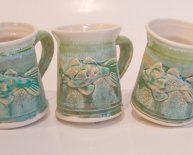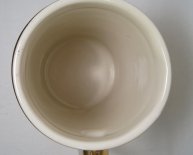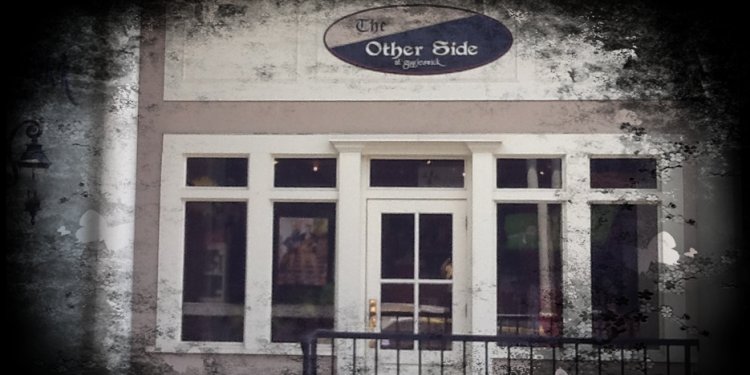
Pottery made in Mississippi
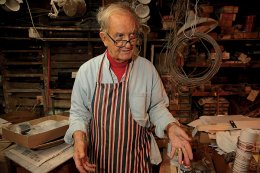 It began after he returned from radar duty in World War II. Lee McCarty, following his graduation from Columbia and a five-year stint teaching chemistry and physics at the University of Mississippi, finally decided he was going home to the town of Merigold, in the Mississippi Delta.
It began after he returned from radar duty in World War II. Lee McCarty, following his graduation from Columbia and a five-year stint teaching chemistry and physics at the University of Mississippi, finally decided he was going home to the town of Merigold, in the Mississippi Delta.
There, he planned to make pottery out of clay. “While we were still up in Oxford, ” he says, “my wife, Pup, had decided she wanted to throw pots. But the only class was at night, and it was full of all these football players from the university. So she said to me, ‘You’re taking the class, too.’ And I did. And I liked it.”
So, in 1954, after more than a decade away from the Delta between the war and college and the teaching stint, Lee and Pup McCarty came home. “And when we got home, ” Lee says, “we began to tell the family what we wanted to do, and Aunt Margaret says to Pup and me, ‘Well, I guess you can have my old mule barn.’”
Potter Lee McCarty.
Out came mules from the aged and rugged wooden barn. And into it went the McCartys—not to mention their clothes, furniture, and one small pottery kiln. During the long and steamy Mississippi summers, they roasted, the kiln adding to the temperature inside. In the damp and raw winters, they wore sweaters and overcoats indoors. They insulated the walls with paper and cardboard. And now, more than fifty-five years later, the pottery that continues to flow out of the mule barn is considered a national treasure.
Items of the McCartys’ pottery travel the world at museum exhibitions and auction sales. Single pieces can go for $10, 000. And the desire for platters, plates, and hanging planters from what’s known in highbrow art circles as “the barn” carries on the wind as far as Japan.
Each McCarty piece is its own work of art, most trademarked by a wavy line coming in from one edge, intended to represent the snaking Mississippi, which sits just a few miles to the west. “I grew up on the Mississippi, ” Lee says. “My father’s business was restaurants. And he always had fishermen who worked the river; the river was a big part of our lives. So as I got to making pottery from native clay, I began to think: I need to incorporate the river into each piece. And that little squiggle of a line is how I did it.”
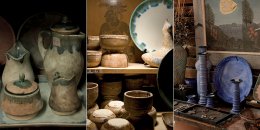 From left: Pottery for sale in the back room of the shop.
From left: Pottery for sale in the back room of the shop.
In fact, to give an idea of how much the soil—not to mention the soul—of Mississippi runs through every piece of McCarty pottery, some of the very first clay used to make McCarty plates and pots came from a ravine on the property of no less than William Faulkner. “Yep, ” Lee says, his voice smiling at the memory. “That started back while I was still teaching at Ole Miss. I decided to show the students how an atom looked like the solar system: with the electrons moving like planets. And we thought we’d make these atoms out of clay. So Mr. Bill took us out there on his place, and he showed us this beautiful deep white-clay ravine and said we could take all the clay that we wanted. That bed of clay was fifty feet deep, at least. Mr. Bill was wonderful. Wonderful.”
Also characteristic of each piece of McCarty pottery are the fired-on glazes, which have evolved into a trio of rich, mellow blue, jade, and, most famously, “nutmeg brown, ” Lee’s favorite color. “Those all eventually came about because of my chemistry background, ” he says. “And the nutmeg began when Pup said to me one day, ‘Let’s mash some coffee grounds into it.’ And that’s one of the experiments that came out well.”
Though Pup passed away two years ago, Lee McCarty continues on. “I work every day, ” he says. “I set out every morning and go until about one o’clock in the afternoon. And my family has joined me. My godson Jamie can throw a beautiful twenty-one-inch candlestick out of local clay fast as somebody else might spoon themselves some peanut butter from a jar.”
In the end, what does Lee like best about his work and career? “It’s allowed me to live here, in Mississippi, ” he says. “It’s allowed me to have a life that has brought good things to me and my family. And interesting people.”
He pauses for a moment, clearly ready to get back to work. “Can I leave you with a piece of advice?” he asks.
Sure.
“Love your wife, ” he says, a wisp of sadness in his voice. “Spoil your children. And then, if you’re lucky enough to have them, as I have been, spoil your grandchildren after that. And all the while make your art in a place that you love.”

